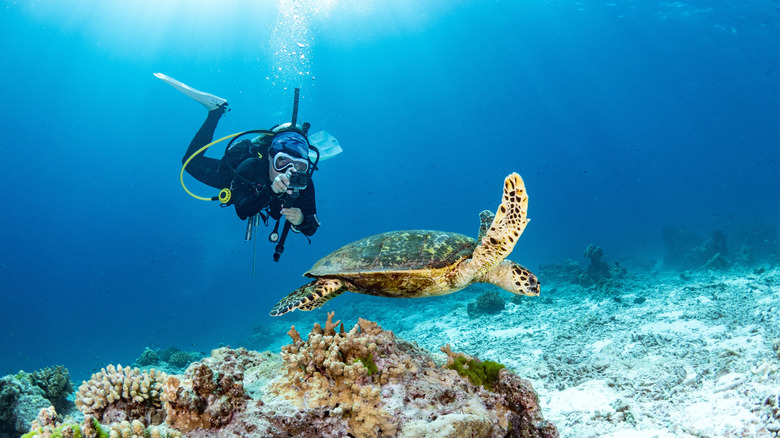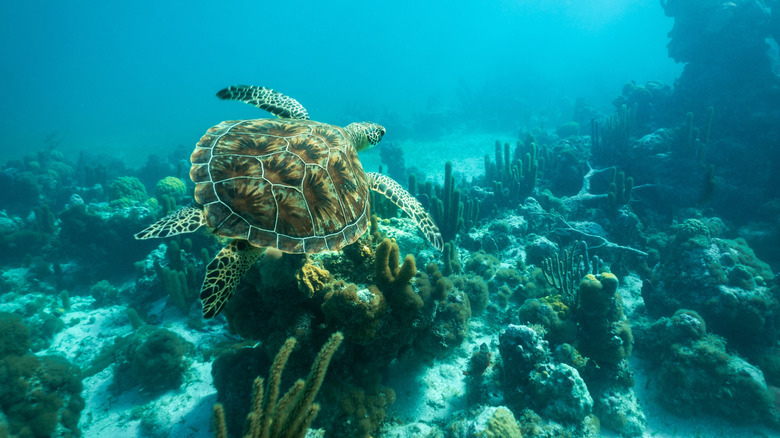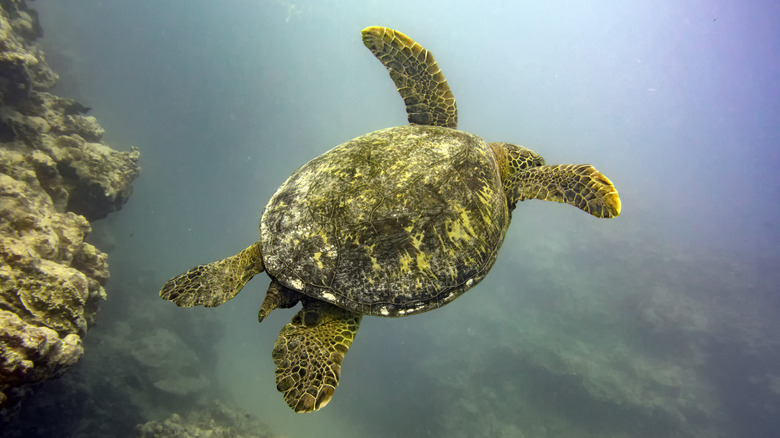The Best Islands Where You Can See Sea Turtles (Other Than Hawaii), According To Research
Few experiences rival the magic of swimming alongside a sea turtle. These majestic creatures have been swimming the seas for 100 million years, and it's nothing short of a privilege for snorkelers and divers to be able to observe them in their natural habitat.
As migratory species, you could theoretically bump into these ancient mariners in all the oceans of the world, depending on their species. Leatherback turtles, for example, are able to withstand the cold waters of Canada and Greenland; green sea turtles can thrive in any ocean (as well as the Mediterranean and Red Sea) except for the freezing Arctic waters; and flatback sea turtles stick to the continental shelves of Australia. But what better spot to swim with sea turtles than on a sun-soaked island? While Hawaii may be the first destination that comes to mind, there are plenty of other breathtaking island destinations around the world to swim with these beautiful, laid-back creatures.
From the waters of a volcanic island in the Philippines to the breathtaking underwater tunnels and arches in the deep blue of Ecuador, these destinations elevate an island beach holiday with turtle encounters. With the help of curated travel lists, diving and snorkeling reviews, and travel websites, here are some of the beguiling island destinations for swimming with sea turtles beyond Hawaii's famous beaches.
Apo Island, Philippines
The Philippines is made up of 7,640 islands, but if there is one fail-safe destination for seeing sea turtles, it's Apo Island. Located about 19 miles from the southeastern tip of Negros Oriental, this small volcanic island screams big sea turtle energy. The waters surrounding Apo Island are part of the Coral Triangle, home to a thriving marine biodiversity. The stats of these waters are jaw-dropping: they host 30.15% of the world's coral reefs, and welcome over 2,000 reef fish species including blue whales, dolphins, and sea turtles.
Green sea turtles swim these waters year-round, as do hawksbill turtles, distinguished by mouths that resemble beaks. The island's turtles are endangered species, so swimming in these waters isn't as straightforward as pitching head-first into the warm turquoise waters, no matter how tempting it would be to do so: Visitors must first register at the tourism office in order to access the island. It's required to have a guide when swimming the waters of Apo Island — a measure of precaution the island is taking as a protected marine sanctuary, a title bestowed on it in 1985. The island's sea turtles tend to feed in shallow waters — it doesn't take more than a snorkel mask and fins to encounter them. Popular snorkeling spots like Chapel Point or Rock Point have amazing visibility, colorful coral beds, and numerous sea turtle sightings.
The Philippines has two seasons — summer and rainy season — and the islands are often battered with typhoons from June to October. Time your visit between December and May, the driest months (and hottest) of the year. Morning dives have calmer swells and give you more alone time with the sea turtles.
Isabela Island, Galápagos Islands, Ecuador
Diving or snorkeling from Isabela Island — the largest of the Galápagos Islands — gives you the opportunity to come face-to-face with the unique Galápagos green turtle, which only nests in these islands. People usually head over to Los Túneles, where arches and tunnels form a surreal backdrop for the bounty of marine wildlife, including sea turtles. Snorkeling in these waters requires booking with a tour operator, as only permit-holding fishermen can take tourists to the key diving spots.
Meanwhile, in Las Tintoreras, Pacific black sea turtles glide through the waters alongside white-tipped reef sharks and Galápagos penguins. Under the protection of the Galapagos National Park, guided tours are required to visit these small black lava islets. Though sharp lava rocks and the presence of sea urchins can be prickly hazards, these nuisances are a small price to pay for the breathtaking underwater landscape thriving beneath the water's surface. And if you aren't keen on getting into the water, you can book some amazing Galápagos Islands cruises instead.
Though sea turtles roam the waters year-round, the best time to swim with the turtles in the Galápagos Islands is from December through June, when the waters are calm and warm for snorkeling. Egg-laying season for green sea turtles begins in January, allowing you to see the sea turtles on land, specifically at their nesting site in Quinta Playa, as well.
Gili Islands, Indonesia
Comprised of a trio of islands — Gili Trawangan, Gili Meno, and Gili Air — the Gili Islands have been dubbed "Turtle Capital of the World" — good news if swimming alongside sea turtles is on your agenda. The three islands are about 15 minutes (give or take) away via speedboat from the Lombok's Bangsal Pier. The islands are home to green sea turtles and the endangered hawksbill turtles, which roam the warm waters all year round.
At Turtle Heaven dive site just off Gili Meno, green sea turtles and hawksbill turtles hover, stately and undisturbed in the calm, shallow waters for your viewing pleasure. Advanced divers can venture into the Deep Turbo dive site near Gili Trawangan, where descending up to 98 feet below the surface reveals a cornucopia of reef sharks, barracudas, eagle rays, snappers, and, of course, sea turtles. Most divers to the Gili Islands make the pilgrimage to the Bask Nest, life-sized underwater sculptures at Gili Meno that were installed as a means of marine wildlife preservation by British sculptor and artist Jason deCaires Taylor.
A non-profit organization, Gili Eco Trust, has been operating on Gili Trawagnan since 2001. Besides island waste management and ecotourism tours, the Eco Trust maintains the reefs through Biorock technology, reef gardening, and coral propagation.
Swimming with the sea turtles in the Gili Islands is a year-round affair, though great underwater visibility is best enjoyed from June to October — if you can bear the tourist crowds. If your schedule allows, aim for the shoulder months (March to June, and October to November), when you'll enjoy more quiet time with the sea turtles.
Providenciales Island, Turks and Caicos
What better place to combine sea turtle sightings and a relaxing beach holiday than Turks and Caicos' Providenciales Island, where snorkeling in one of the world's best barrier reefs is just a few steps from the shore? Swimming with sea turtles in Providenciales requires little effort and preparation: You can simply wade into the water from the beach, though you can still book a snorkeling cruise, which often grants better underwater visibility.
The island's most popular snorkeling spot to see green and hawksbill sea turtles is Smith's Reef. Just 75 feet from Bight Beach's shore, the ocean floor carpeted in seagrass — a perfect feeding ground for green sea turtles. These seagrass areas bookend Bight Reef (Coral Gardens), where you can find hawksbill turtles that forage on coral reefs using their pointed beaks. Preserving the sea turtle population in Turks and Caicos has been an ongoing effort. With the help of the local government, the Turks and Caicos Islands Turtle Project has enforced the protection of turtle eggs, banned catching rare turtle species such as loggerhead, leatherback, Olive Ridley, and Kemp's Ridley turtles, and tracked several turtles through attached satellite transmitters.
The ideal months for snorkeling are between November and April, when the weather brings sunshine, light breezes, and little rain. But if you want to avoid the tourists and don't mind rainy conditions, booking between May and October can get you more bang for your buck, from cheaper accommodations, tour packages, and flights — and the water's visibility will often still be good for morning snorkeling sessions.
Cook Island Marine Reserve, Australia
On the north coast of New South Wales lies Australia's Cook Island Aquatic Reserve (Jungarra Ngarrian), home to a colony of green sea turtles and loggerhead turtles. As one of the 12 aquatic reserves in the state, the island's marine ecosystem and landscape have been fiercely preserved, yielding a healthy population of sea turtles, manta rays, leopard sharks, and tropical fish happily co-existing in the rocky reefs and corals of the reserve. Nicknamed Turtle Island, swimming with sea turtles in Cook Island is a year-round possibility, especially if you head for the northern side of the island, the site of the calmest waters and a popular spot for sea turtle sightings. Meanwhile, you'll also find sea turtles moored and feeding on the sea grass on the eastern side of the island.
Accessible via organized tours that leave by boat from Tweed Heads, Cook Island Aquatic Reserve appeals to both beginners and advanced divers — depending on the ocean's conditions. Waters can get choppy, so defer to your tour guide operators when it comes to ideal diving conditions. With the turtles' calm demeanor and majestic presence, it may be tempting to reach out and touch them, but it's essential that you don't: Divers are advised to keep at least 15 feet of distance from the sea turtles. May to October are the most ideal months for a visit, taking note that July and August are peak tourist season.
Methodology
In order to come up with the best island destinations for swimming with sea turtles, we consulted curated lists from trusted sources like PADI, Snorkeling Report, Lonely Planet, Wanderlust, and more. For a well-rounded overview, we selected amazing sea turtle destinations from different oceans: the Atlantic, Indian, and Pacific (southern and western). First-hand reviews from divers and snorkeling enthusiasts were also taken into consideration when writing about the islands. Additional information from sea turtle conservation groups and snorkeling and diving tour guide operators gave us an overview of the islands' efforts in providing safe habitats for these gentle mariners.






